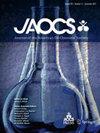Development of dual stage solvent fractionation as an approach to concentrate carotenoids from crude palm oil with high recovery: The potential use of molecular simulation as a pre‐screening tool
IF 1.9
4区 农林科学
Q3 CHEMISTRY, APPLIED
引用次数: 0
Abstract
Crude palm oil (CPO) is highly abundant in carotenoids. Previous findings found that dry fractionation can concentrate carotenoids from CPO but resulted in a significant loss of carotenoids. Therefore, the present study aimed to utilize solvent fractionation, which offers a better separation efficiency, to concentrate carotenoids from CPO with improved recovery. Computational study revealed a high binding affinity of phytonutrient towards unsaturated triacylglycerols (TAGs) species in olein fraction due to similar polarity. This prediction was further verified with evidence showing strong, positive correlation between the iodine value and carotenoids concentrations of fractionated oil. The difference in binding affinity of saturated and unsaturated TAG towards different solvents can be used as a guide for screening and selection of solvent suitable for recovery of phytonutrient during solvent fractionation. Subsequently, a lab‐scale single‐ stage fractionation study disclosed that crystallization temperature of 15°C, oil to acetone ratio of 1:5 (w/v) for 4 h under agitation at 100 rpm produced olein with the highest carotenoid concentration (637 ppm) and recovery (94%). Subsequent double‐stage fractionation successfully concentrated the carotenoids up to 125% with a recovery of >93%. Conclusively, solvent fractionation provides an effective way to concentrate valuable carotenoids from CPO while minimizing the lost.双级溶剂分馏从粗棕榈油中提取高回收率类胡萝卜素的方法的发展:分子模拟作为预筛选工具的潜在用途
粗棕榈油(CPO)富含类胡萝卜素。先前的研究发现,干燥分馏可以从CPO中浓缩类胡萝卜素,但会导致类胡萝卜素的显著损失。因此,本研究旨在利用分离效率较高的溶剂分馏法从CPO中提取类胡萝卜素,并提高其回收率。计算研究表明,植物营养素与油质组分中不饱和三酰甘油(TAGs)具有较高的结合亲和力,因为它们具有相似的极性。有证据表明,分馏油的碘值与类胡萝卜素浓度之间存在强烈的正相关关系,进一步证实了这一预测。饱和和不饱和TAG对不同溶剂结合亲和力的差异,可作为溶剂分离过程中筛选和选择适合回收植物营养素的溶剂的指导。随后,一项实验室规模的单级分馏研究表明,结晶温度为15°C,油与丙酮的比例为1:5 (w/v),在100 rpm下搅拌4小时,产生的油蛋白具有最高的类胡萝卜素浓度(637 ppm)和回收率(94%)。随后的双级分馏成功地将类胡萝卜素浓缩至125%,回收率>93%。综上所述,溶剂分馏是一种有效的方法,可以从CPO中提取有价值的类胡萝卜素,同时减少损失。
本文章由计算机程序翻译,如有差异,请以英文原文为准。
求助全文
约1分钟内获得全文
求助全文
来源期刊
CiteScore
4.10
自引率
5.00%
发文量
95
审稿时长
2.4 months
期刊介绍:
The Journal of the American Oil Chemists’ Society (JAOCS) is an international peer-reviewed journal that publishes significant original scientific research and technological advances on fats, oils, oilseed proteins, and related materials through original research articles, invited reviews, short communications, and letters to the editor. We seek to publish reports that will significantly advance scientific understanding through hypothesis driven research, innovations, and important new information pertaining to analysis, properties, processing, products, and applications of these food and industrial resources. Breakthroughs in food science and technology, biotechnology (including genomics, biomechanisms, biocatalysis and bioprocessing), and industrial products and applications are particularly appropriate.
JAOCS also considers reports on the lipid composition of new, unique, and traditional sources of lipids that definitively address a research hypothesis and advances scientific understanding. However, the genus and species of the source must be verified by appropriate means of classification. In addition, the GPS location of the harvested materials and seed or vegetative samples should be deposited in an accredited germplasm repository. Compositional data suitable for Original Research Articles must embody replicated estimate of tissue constituents, such as oil, protein, carbohydrate, fatty acid, phospholipid, tocopherol, sterol, and carotenoid compositions. Other components unique to the specific plant or animal source may be reported. Furthermore, lipid composition papers should incorporate elements of yeartoyear, environmental, and/ or cultivar variations through use of appropriate statistical analyses.

 求助内容:
求助内容: 应助结果提醒方式:
应助结果提醒方式:


